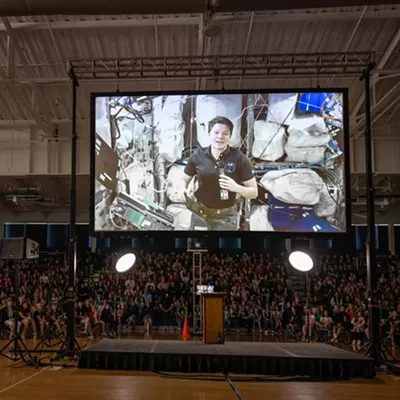Simplicity is complicated. Just trying to settle on a definition can lead to confusion. Is it a philosophy, as taught and practiced by religious leaders from the Buddha to Jesus to Gandhi? Is it a social phenomenon, as in the Voluntary Simplicity movement that has burgeoned over the past 10 or 15 years? Is it an ascetic lifestyle akin to that modeled by Henry David Thoreau or his 20th-century back-to-nature followers? Or is it an aesthetic, a minimalist style of design or decor that emphasizes clean lines and spare, light-filled spaces?
Perhaps simplicity is all of these and then some. An architect may give an entirely different answer from a philosopher, but that's part of the beauty of simplicity, according to people who have adopted the tenets of Voluntary Simplicity in their lives. And someone may choose to design a home using the aesthetics of simplicity or minimalism without knowing -- or indeed caring -- about the Voluntary Simplicity movement.
"I think we need to draw a distinction between minimalism as an aesthetic pursuit and adopting minimalism as a way of life," says Matt Melcher, assistant professor of interior design at WSU-Spokane. "The latter represents the attempt to simplify one's life through the elimination of the non-essential, while the former would be the archetypal expression of that pursuit, more of an aesthetic pursuit. Those two things are not mutually inclusive."
In addition to his full-time faculty duties, Melcher provides design services to clients with his wife, Juliet Sinisterra, through their firm IDR Studio. "A client may come to us wanting one or the other, either to project the semblance or illusion of a simple lifestyle, or someone coming very honestly to us wanting to simplify their home as a philosophical tenet that they're trying to follow." But, as a cautionary note, he adds, "Tied in to that is the misconception that design can simplify your life."
Voluntary Simplicity advocates are not the first to integrate a lifestyle or philosophy into home design. Back in the mid-19th century, the Shakers created ingenious yet elegantly simple designs for homes and furnishings that manifested their motto of "Hands to work, hearts to God." A Shaker chair displays little ornamentation, but it is eminently functional. The same can be said for an Asian-inspired aesthetic, which seeks serenity and balance in design. "Asian design has an understated simplicity," says Leslie Ann Schifferns, director of the interior design program at Spokane Falls Community College. "It's a creative spirit based on natural materials in their natural state."
Although there have been several books published recently on simplifying home decor, both Melcher and Schifferns mention the work of architect Sarah Susanka of Minneapolis, whose books have brought simplicity in architecture to a broad audience. Susanka is the author of two best-selling books: The Not So Big House, published in 1998, and Creating The Not So Big House, released in 2000, both by Taunton Press.
Susanka's principles of Not So Big begin with the notion of quality over quantity. Rather than just expanding the square footage of a home, she suggests putting more resources into quality materials and meaningful, functional design. Creating a home with character is one of the primary goals.
"Character is what gives identity to our places," says Schifferns. "Character comes from our culture, our personalities, the materials used and a home's relationship to the landscape. Rather than square footage, you put the money into quality materials and construction."
In her books, Susanka presents home designs that complement the clients' way of living in the space instead of just mirroring the latest styles. Not So Big emphasizes comfort over size and volume, stressing the need for spaces that feel cozy, comfortable and inviting. The focus is on keeping the home's scale in line with the typical adult human height (between just under five feet and the mid-six-foot range). She notes that proportion -- the relationship between the vertical and horizontal dimensions -- is frequently lost in the "starter castles" and "trophy homes" that crowd so many new suburban developments. Ideally, she says the Not So Big House should use sustainable design and construction methods, along with quality craftsmanship and a harmonious blending with the surrounding landscape.
In her second book, Susanka discusses a variety of design techniques to accomplish the goals of Not So Big building. For example, differences in ceiling heights can serve to separate rooms visually while maintaining an open floor plan; lower ceilings also create a space that feels more comfortable and on a human scale. Using framed openings -- larger than doors -- between rooms allows natural light to flow into the home's interior and provides a sense of openness. She also recommends using natural materials as much as possible.
Here in Spokane, Melcher and Sinisterra have had practical experience applying Susanka's theories. One of their clients arrived a couple of years ago with a copy of The Not So Big House tucked under her arm, Melcher says. Faith Hayflich and her husband, Charlie Boettcher, had just come to Spokane from the Silicon Valley seeking a change from the overcrowded Bay Area and its frantic lifestyle. Faith, who is a yoga instructor, sought to adopt the book's principles as they searched for their new home.
"I think, for Faith and Charlie, coming to us was an earnest and invested attempt to simplify their lifestyle," Melcher says. "They were particularly interested in the experiential power of connecting with the landscape."
Boettcher and Hayflich considered new construction initially, but they were put off by the sheer size of homes in the newer developments. They had the resources to make a substantial investment in their home but became increasingly dismayed at the choices available to them. "We found that the more money you'd spend, you'd just get a bigger house, not better materials," Hayflich remembers. "We don't need a formal dining room because we don't entertain like that, and we don't need lots of family room space because we don't have kids at home. We don't need a 6,000-square-foot house. We couldn't figure out what was wrong until we saw The Not So Big House."
Hayflich and Boettcher soon found an existing home in a location that they loved. Although they didn't love the home's interior spaces, they liked the way the house sat into the landscape, looking like it belonged there. At more than 4,000 square feet, the house was certainly not small, but it was smaller than the new homes they had seen, and they liked its unassuming exterior.
Melcher and Sinisterra analyzed the functional and spatial needs presented by their new clients. They wanted several smaller, more intimate spaces good for quiet, solitary activities like reading, yoga or developing photos, rather than the oversized great rooms typical of many large new homes. "She was interested in compartmentalizing what she did in a day," Melcher says. "The approach became one of developing rooms that were spatially connected and interrelated but that used architectonic devices to differentiate them, like different ceiling planes and arched connections."
The arched openings in particular allowed a series of smaller spaces to "borrow" space from one another to get the sense of interconnectedness, he says.
Bringing natural light to the home's interior was another clear desire of the homeowners, so the design incorporated a number of skylights. "We wanted a house that was cozy, but open and light at the same time," says Hayflich. "Those may seem like opposites, but Matt and Juliet were able to do it." The duo incorporated other Not So Big principles, such as the use of natural and recycled materials, an energy-efficient geothermal heating system, landscaping using native, drought-tolerant plants and attention to well-crafted details.
"I like the premise of having less square footage but putting the money into the details instead," says Hayflich. Among those character-creating details are cherry cabinets and built-ins, granite countertops and maple flooring and baseboards. Now, as the major remodel nears completion, Hayflich says she and her husband are happy with the result. "It's comfortable," she says. "The space works for us."
Hayflich shares many of the values of the Voluntary Simplicity movement, although, like a lot of people, she doesn't think her lifestyle could truthfully be labeled simple. Still, she wanted to incorporate those values into the design of her home. "From my yoga experience, I look carefully at what I need, and I try to not accumulate a lot," she says. "I like clear space and simple lines that minimize the visual noise."
















